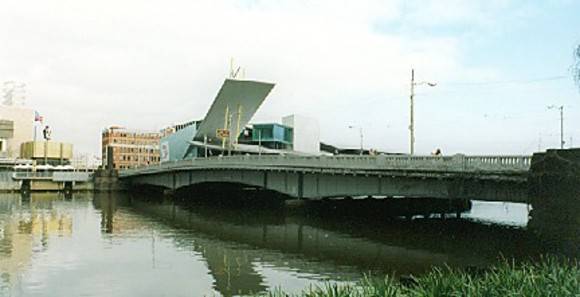| Back to search results » | Back to search page » |
|
Spencer Street Bridge
Other NameVicroads Structure Id. Sn6237 LocationBetween Spencer Street & Clarendon Street,, MELBOURNE VIC 3000 - Property No B6799
File NumberB6799LevelState |
|
Statement of Significance
What is significant? The Spencer Street Bridge built by the Victorian Railways Construction Branch in 1929-30 is significant as a major new crossing of the Yarra River reflecting engineering and design standards intended to enhance the Yarra River as an aesthetic and recreational adjunct to the City of Melbourne.
How is it significant? The Spencer Street Bridge is significant for aesthetic/architectural, historic, and technical reasons at a State level.
Why is it significant? Spencer Street Bridge was constructed after a long period of stagnation in road and bridge development in Victoria in a climate of controversy and rivalry between public authorities, local councils and politicians.
The Spencer Street Bridge is of historical significance as the first major new crossing (as opposed to replacement of older bridges on existing crossings such as the 1924 Church Street Bridge) to be created over the lower Yarra in Melbourne after a considerable lull in such projects since the Morell Bridge of 1899-1900. Its construction demonstrates the political difficulties of the time and the growing importance of motor vehicle traffic to Melbourne's commerce. The Spencer Street Bridge was the first permanent structure over the Yarra built below "the falls" (a natural rock barrier that formed the upstream limit of practical river navigation) and as such is historically important because it was the first bridge to effectively cut the city off from direct contact with its port. For five decades Spencer Street was the furthest downstream bridge on the Yarra River and today still forms a principal gateway to the central business district and one of the most significant Yarra crossings.
The bridge is also of historical significance as the largest and most prominent road bridge built by the Victorian Railways Construction Branch during a decade in which the influence and importance of this railways design office reached a peak, undertaking several major bridge and railway construction projects in New South Wales and Malaya, in addition to the construction of some 700 km of new railway and several major railway bridges within Victoria.
The Spencer Street Bridge is also of historical significance for its role in the political and local infighting, which hindered cooperation between the various authorities with a stake in the crossing, preventing the bridge being built for many years. It is also noteworthy for the social changes it created in Melbourne by altering travel and communication patterns between suburbs, industrial areas and the city following its construction.
The bridge is of technical significance as the earliest known variable depth steel plate girder bridge in Victoria and one of the earliest examples of composite road bridge design in which plate girders were "keyed" to a cast in-situ reinforced concrete deck by shear connectors to form an integral structure with enhanced stiffness. While this was not part of structural design for increasing bearing capacity of the bridge it predicts design trends that became standard in the 1930s.
The riveted steel girders were fabricated by Kelly & Lewis Pty. Ltd., one of Victoria's most prominent engineering firms in the early 20th century, and are a rare and early example of both variable-depth plate girders and the combination of cantilevered and suspended spans. The 33.66 m centre span of the Spencer Street Bridge is the second-longest extant riveted metal plate girder road bridge span in Victoria (after the 42.7 m Keilor Bridge over the Maribyrnong) and the ninth-longest span amongst all plate girder road bridges in the State. The unusual length and innovative design of the Spencer Street Bridge girders and their application in a composite structural form with a shear connected reinforced concrete deck, is of importance in the development of bridge engineering technology in Victoria during the interwar years, a period when standardisation in bridge design was becoming the norm under the CRB, but experimentation and innovation was also apparent.
The bridge is of aesthetic significance as a representative example of the nature of large civic construction of the interwar period with its subdued Art Deco design. The aesthetic design qualities of the bridge are apparent in its understated and somewhat austere parapets and pylons utilising the standard Melbourne building material of bluestone, as well as the combination of a humped or arched overall deck profile over the three individual arches of each variable depth girder span.
The alterations to the bridge in recent years have been unsympathetic due to the lack of appreciation of the significance of the bridge. However, its historical and technical values are still intact and can be appreciated despite changes in the vicinity, such as the addition of a modern footbridge (to an award winning design by Peter Elliot) on the downstream side.
Unsympathetic removal of balustrade panels on west side and proximity of foot bridge detract from the bridge's significance.
Classified: 07/07/2003
Group
Transport - Road
Category
Road Bridge




